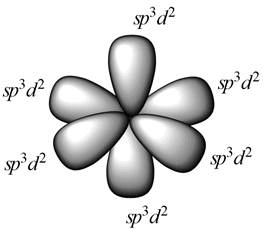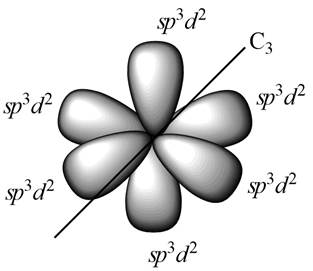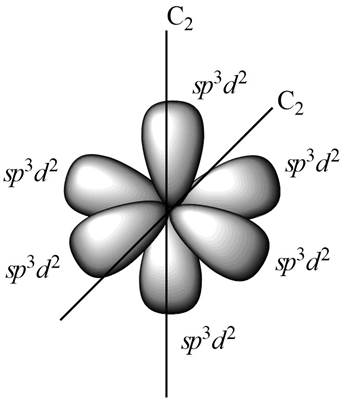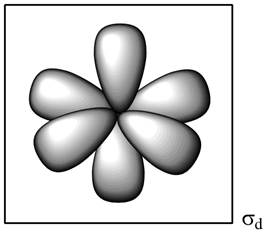
Interpretation:
The
Concept introduction:
The characters of the irreducible representations of the given point group can be multiplied by each other. The only condition is that the characters of the same symmetry operations are multiplied together. The multiplication of the characters is commutative.
The great orthogonality theorem for the reducible representation can be represented as,
Where,
•
•
•
•
•
Answer to Problem 13.84E
The
Explanation of Solution
The symmetry elements present in octahedral symmetry are,

Figure 1
For the symmetry element

Figure 2
All the
For

Figure 3
The
The
The
On inversion of the given set of orbitals, all the hybrid orbitals exchange their position and their contribution is
For
For
For
For
This plane can be represented as,

Figure 4
Thus, the reducible representations from the given contribution is,
The great orthogonality theorem for the reducible representation can be represented as,
Where,
•
•
•
•
•
The order of the group is
Substitute the value of order of the group, character of the class of the irreducible representation from character table of
The number of times the irreducible representation for
Similarly, for
The number of times the irreducible representation for
Similarly, for
The number of times the irreducible representation for
Similarly, for
The number of times the irreducible representation for
Similarly, for
The number of times the irreducible representation for
Similarly, for
The number of times the irreducible representation for
Similarly, for
The number of times the irreducible representation for
Similarly, for
The number of times the irreducible representation for
Similarly, for
The number of times the irreducible representation for
Similarly, for
The number of times the irreducible representation for
Thus, the linear combination is
The
Want to see more full solutions like this?
Chapter 13 Solutions
Physical Chemistry
- Explain why a molecule with a center of inversion cannot have a dipole moment.arrow_forwardDetermine if the following species have permanent dipole moments. a Dichloromethane, CH2Cl2 b Chlorobenzene, C6H5Cl c Ammonia, NH3 d Carbon dioxide, CO2.arrow_forwardIdentify the symmetry elements present in the following objects. a The Eiffel Tower. You may have to look up a picture of it if you dont remember its shape b Any book ignore the printing. c An octagonal wood block. d A jack from the set of jacks pictured here: Note that some of the points end differently.arrow_forward
- Considering only the molecular orbitals formed by combinations of the 2s atomic orbitals, how many molecular orbitals can be formed by 1000 Li atoms? In the lowest energy state, how many of these orbitals will be populated by pairs of electrons and how many will be empty?arrow_forwardUsing its x, y, and z coordinates, construct the 15 x 15 matrix that describes the application of the S4 symmetry operation to square planar [PtCl 4]2- What is the character of this matrix?arrow_forwardWhat is the difference between the symmetry operators and point groups of NF3 and NF2CI?arrow_forward
- 4. Show that the function x y z has symmetry species A1 in pt group D2,arrow_forwardDetermine all the symmetry elements of the following molecules Ethene Tetraphenylmethane , C(C6H5)4arrow_forwardSet up the secular determinants for (i) azulene (3), (ii) acenaphthylene (4) within the Hückel approximation and using the out-of-plane C2p orbitals as the basis set.arrow_forward
- Describe the [3,3] sigmatographic rearrangement as a simmetry of the orbital.arrow_forwardIdentify the operations, the symmetry elements and the PointGroup of the molecules below: a)H2S; b)CO2; c) [PtBr4]2−; d)BF3; e)SF4; f)CH2Cl2; g)NbCl5; h)SF5Cl; i)N2H4arrow_forwardList all the symmetry elements of a Cr(CO)6 molecule and identify the symmetry point group to which it belongs.arrow_forward
 Physical ChemistryChemistryISBN:9781133958437Author:Ball, David W. (david Warren), BAER, TomasPublisher:Wadsworth Cengage Learning,
Physical ChemistryChemistryISBN:9781133958437Author:Ball, David W. (david Warren), BAER, TomasPublisher:Wadsworth Cengage Learning, Chemistry & Chemical ReactivityChemistryISBN:9781337399074Author:John C. Kotz, Paul M. Treichel, John Townsend, David TreichelPublisher:Cengage Learning
Chemistry & Chemical ReactivityChemistryISBN:9781337399074Author:John C. Kotz, Paul M. Treichel, John Townsend, David TreichelPublisher:Cengage Learning Chemistry & Chemical ReactivityChemistryISBN:9781133949640Author:John C. Kotz, Paul M. Treichel, John Townsend, David TreichelPublisher:Cengage Learning
Chemistry & Chemical ReactivityChemistryISBN:9781133949640Author:John C. Kotz, Paul M. Treichel, John Townsend, David TreichelPublisher:Cengage Learning


